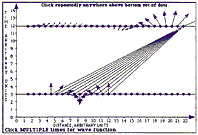
Quantum Mechanics
 Feynman's
sum-over-paths quantum theory simply commands the electron: Explore
all paths. Students model this command with the computer, pointing
and clicking to tell the electron which paths to explore; wave functions
and bound states arise naturally. This story line and the results
of early trials with students are described more fully in the publication "Teaching
Feynman's Sum Over Paths Quantum Theory," Edwin F. Taylor,
Stamatis Vokos, John M. O'Meara, and Nora S. Thornber, Computers
in Physics 12, 190-199 (Mar/Apr 1998).
Feynman's
sum-over-paths quantum theory simply commands the electron: Explore
all paths. Students model this command with the computer, pointing
and clicking to tell the electron which paths to explore; wave functions
and bound states arise naturally. This story line and the results
of early trials with students are described more fully in the publication "Teaching
Feynman's Sum Over Paths Quantum Theory," Edwin F. Taylor,
Stamatis Vokos, John M. O'Meara, and Nora S. Thornber, Computers
in Physics 12, 190-199 (Mar/Apr 1998).
The new teaching materials are based on the little book of popular lectures given by Richard Feynman: QED, The Strange Theory of Light and Matter (Princeton, 1985).
DRAFT
software and DRAFT student exercises:
Software and
workbook documents are available for FREE
DOWNLOAD from this website.
copyright 2024, Edwin F. Taylor, All Rights Reserved
eftaylor631@gmail.com